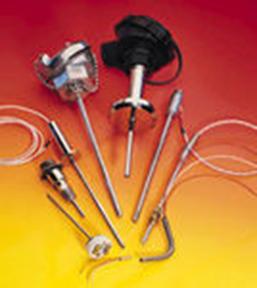

|
CATALYTIC TEMPERATURE SENSOR |
|
CUMMINS II |


|
Wire Wound vs. Thin Film
Since many different factors affect whether or not the constraints are met, it was necessary to choose each factor in order of importance. The factor that has the biggest overall effect on the performance of the RTD is whether it is a thin film design or wire wound. This decision mainly affects the maximum temperature of the system and the dynamic response. Because the RTD will not work if it cannot withstand the maximum temperature, this was determined to be the most important constraint. Several thin film RTDs were studied to see if one with a proper sheath and large enough construction would be able to withstand the required maximum temperatures. After a great deal of investigation, thin film RTDs were eliminated.
Traditional Wire Wound, Hollow Annulus and Coil Element
With thin film RTDs eliminated, the analysis was on platinum wire wound RTDs. Next, the decision had to be made if a traditional wire wound design would work, or if a coil element or hollow annulus setup would be necessary. Hollow annulus designs are a fairly new design and are not yet durable enough to withstand 188,000 miles at high temperatures. A coil element would work well for this application but due to the complexity of its design and difficulty to produce, it would be near impossible to build 250,000 units per year. Traditional wire wound RTD elements are the only adequate solution.
Self Heating
Self heating was another concern that needed to be addressed when considering RTD construction. Calculations showed that with the high airflow rates in the vehicle’s exhaust, much of the heat created by the current through the RTD would be dissipated. The small amount of heat generated would be negligible when compared to the high temperatures of the exhaust gases. Since self heating increases as RTD size decreases, these calculations were initially made using a very small RTD. This having been done, it was determined that self heating would not have to be taken into consideration when determining sensor size.
Manufacturers
Before more calculations were computed, it was necessary to make sure a manufacturer would be willing to produce this device. After thorough analysis of dozens of RTD manufacturer’s products and abilities, several were chosen as possible candidates for building a suitable RTD. Initial proposals were submitted to see which were capable of producing this device. The requirement that eliminated most companies was the maximum temperature of the sensor. Currently only Minco and Omega have the expertise to manufacture an RTD for this application.
Since class B platinum RTDs are the only ones able to reach a high enough temperature for this application, it was decided that the best suited RTD from each producer would be one there smallest class B. This decision was made based on the fact that size was not a factor for that needed to be considered for self heating, and that smaller RTDs have quicker dynamic responses.
Omega
Based on the previous analysis, a ceramic wire wound platinum RTD element has been selected from Omega. The element is a 100 Ohm, class B detector and is relatively cheap. With a length of 25 mm and thickness of 1.5 mm, this element offers versatile qualities and is capable of fitting in a variety of probes small enough for exhaust application. The element can accurately measure temperatures between -200°C and 850°C. Typically it is best to buy the RTD element and probe already assembled from the manufacturer. Current probe specifications are being discussed with Omega and soon a selection will be made.
Figure: 5.1: Ceramic wire wound RTD element from Omega
Minco
Minco sells all of their RTDs already combined with a probe. Another 100 Ohm class B ceramic wire wound platinum element was selected from Minco with a temperature range of -200°C and 850°C. The probe will be 4mm wide and have a length of 6 inches. The case is made of a nickel allow, which provides excellent protection from exhaust gases and also results in a quick dynamic response. This product is also available in 3 or 4 wire configurations.
Figure: 5.2: Ceramic wire wound RTD element from Minco with nickel alloy sheath
The last decision to be made was wire configuration. A two wire setup was immediately ruled out in our application. A three wire configuration would work fine if care was taken to ensure the lead wires were both of equal resistance. The four wire setups are slightly more expensive, but will eliminate almost all possibilities of error due to wiring. The deciding factor wire configuration will have to be based on the electrical systems of the vehicles. A three wire arrangement will require a constant voltage source to work properly, while the four wire assembly will require a constant current source. The cost of modifying or creating a new power source would far exceed the cost of upgrading from three to four wires. It would also exceed the cost required to assure the lead wires are of equal resistance. From this information it was concluded that the best wiring would be based on what electronics were already available in the vehicle. |
|
PRODUCT SELECTION |




